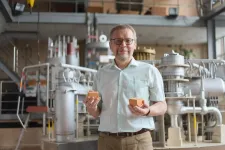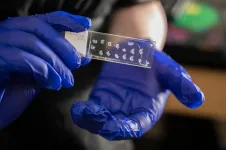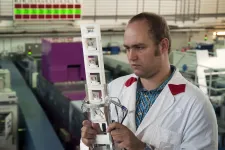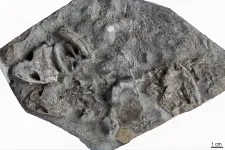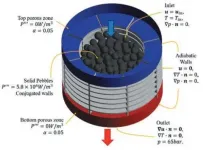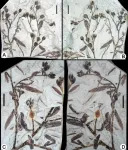INFORMATION:
Scientists created building materials effectively protecting from radiation
Bricks made of new materials are cheaper and more environmentally friendly than analogues made of lead and other materials
2021-05-21
(Press-News.org) Scientists at the Ural Federal University (UrFU, Russia) have created clay bricks that are able to attenuate ionizing radiation to a level that is safe for the human body. To the composition of bricks scientists add waste from the industry, which protects against radiation. The article describing the technology was published in the journal Applied Radiation and Isotopes.
"Bricks are a relatively cheap and convenient material with which we can quickly erect protective rooms, structures, walls around objects with radiation," says scientific head of the project, associate professor of the Department of Nuclear Power Plants and Renewable Energy Sources at UrFU Oleg Tashlykov. "The bricks are alloyed with heavy metals - wastes from the metallurgical enterprises. These substances have pronounced radiation-protective properties. Thus, we solve two problems at once. First, by adding crushed absorbers of ionizing radiation to the matrix, in this case from clay, we obtain building materials with the desired protective properties. Secondly, in this way we find a way to utilize industrial waste."
The ultimate goal of scientists is to develop a wide range of materials based not only on clay, but also cement mortars or concrete, artificial polymers with different chemical composition and concentration of absorbing substances. In other words, with specified protective properties that meet specific conditions (isotopic composition of radioactive contamination, types of radiation, etc.) at nuclear power plants, in radioactive waste storage facilities, as well as in medical institutions where diagnostics and treatment are carried out using X-ray equipment and irradiating devices.
"Tungsten is widely known to be the most reliable protection against gamma or X-ray radiation, but it is very expensive," says research coauthor, research engineer of the Department of Nuclear Power Plants and Renewable Energy Sources at UrFU Karem Makhmud. "Lead is cheaper but toxic. And, besides, it is plastic and in an upright position can slide under its own weight, forming holes in the radiation protection system and reducing its stability. Our materials are optimal in terms of radiation protection efficiency and ease of manufacture, strength, durability, cost. The latter factor is important, since today the contribution of biological protection to the cost of nuclear power facilities reaches 20-30%."
Scientists use high-precision computational codes to create bricks. Also they use for their experimental research the reactor plant of the Institute of Reactor Materials of the State Corporation "Rosatom" (Russia), as well as the production technologies of the Sealing Materials Plant (Russia). The products of joint activities are of great interest to domestic and foreign enterprises of the nuclear industry. There are plans to further study the mechanical and radiation-protective parameters of various natural substances, including those common in the partner countries of Rosatom (Turkey, Egypt, Bangladesh), where nuclear power plants are being built with the participation of Russian specialists.
ELSE PRESS RELEASES FROM THIS DATE:
Itch insight: Skin itch mechanisms differ on hairless versus hairy skin
2021-05-21
Chronic skin itching drives more people to the dermatologist than any other condition. In fact, the latest science literature finds that 7% of U.S. adults, and between 10 and 20% of people in developed countries, suffer from dermatitis, a common skin inflammatory condition that causes itching.
"Itch is a significant clinical problem, often caused by underlying medical conditions in the skin, liver, or kidney. Due to our limited understanding of itch mechanisms, we don't have effective treatment for the majority of patients," said Liang Han, an assistant professor in the Georgia Institute of Technology's School of Biological Sciences who is also a researcher in the Parker H. Petit Institute for Bioengineering and Bioscience.
Until ...
Darwin foreshadowed modern scientific theories
2021-05-21
When Charles Darwin published Descent of Man 150 years ago, he launched scientific investigations on human origins and evolution. This week, three leading scientists in different, but related disciplines published "Modern theories of human evolution foreshadowed by Darwin's Descent of Man," in Science, in which they identify three insights from Darwin's opus on human evolution that modern science has reinforced.
"Working together was a challenge because of disciplinary boundaries and different perspectives, but we succeeded," said Sergey Gavrilets, lead author and professor in the Departments of Ecology and Evolutionary Biology and Mathematics at the University of Tennessee, Knoxville.
Their goal with this review summary was to apply the framework ...
SPRINT study confirms controlled blood pressure important in preventing heart disease and stroke
2021-05-21
CLEVELAND - Follow-up data from the landmark SPRINT study of the effect of high blood pressure on cardiovascular disease have confirmed that aggressive blood pressure management -- lowering systolic blood pressure to less than 120 mm Hg -- dramatically reduces the risk of heart disease, stroke, and death from these diseases, as well as death from all causes, compared to lowering systolic blood pressure to less than 140 mm Hg. Systolic blood pressure (SBP) is the upper number in the blood pressure measurement, 140/90, for example.
In findings published in the May 20, 2021 issue of the New England Journal of Medicine, investigators presented new evidence of the effectiveness of reducing SBP to a target range of less than 120 ...
Making the gray cells happy
2021-05-21
Depressive disorders are among the most frequent illnesses worldwide. The causes are complex and to date only partially understood. The trace element lithium appears to play a role. Using neutrons of the research neutron source at the Technical University of Munich (TUM), a research team has now proved that the distribution of lithium in the brains of depressive people is different from the distribution found in healthy humans.
Lithium is familiar to many of us from rechargeable batteries. Most people ingest lithium on a daily basis in drinking water. International studies have shown that ...
CVIA has just published a new issue, Volume 5 Issue 4
2021-05-21
Beijing, 19 May 2021: the journal Cardiovascular Innovations and Applications (CVIA) has just published a new issue, Volume 5 Issue 4.
This issue brings together important research from leading cardiologists in US and China in a combination of reviews, original research and case reports.
REVIEWS
Pei Huang, Yi Zhang, Yi Tang, Qinghua Fu, Zhaofen Zheng, Xiaoyan Yang and Yingli Yu
Progress in the Study of the Left Atrial Function Index in Cardiovascular Disease:
A Literature Review (https://tinyurl.com/3vruva37)
Nikhil H. Shah, Steven J. Ross, Steve A. Noutong Njapo, Justin Merritt, Andrew Kolarich, Michael Kaufmann, ...
Best predictor of arrest rates? The 'birth lottery of history'
2021-05-21
Social scientists have had a longstanding fixation on moral character, demographic information, and socioeconomic status when it comes to analyzing crime and arrest rates. The measures have become traditional markers used to quantify and predict criminalization, but they leave out a crucial indicator: what's going on in the changing world around their subjects.
An unprecedented longitudinal study, published today in the American Journal of Sociology, looks to make that story more complete and show that when it comes to arrests it can come down to when someone is rather than who someone is, a theory the researchers refer to as the birth lottery of history.
Harvard sociologist Robert J. Sampson and Ph.D. candidate Roland Neil followed arrests in the lives of more than ...
Pandemic paleo: A wayward skull, at-home fossil analyses, a first for Antarctic amphibians
2021-05-21
Paleontologists had to adjust to stay safe during the COVID-19 pandemic. Many had to postpone fossil excavations, temporarily close museums and teach the next generation of fossil hunters virtually instead of in person.
But at least parts of the show could go on during the pandemic -- with some significant changes.
"For paleontologists, going into the field to look for fossils is where data collection begins, but it does not end there," said Christian Sidor, a University of Washington professor of biology and curator of vertebrate paleontology ...
Researchers develop advanced model to improve safety of next-generation reactors
2021-05-21
When one of the largest modern earthquakes struck Japan on March 11, 2011, the nuclear reactors at Fukushima-Daiichi automatically shut down, as designed. The emergency systems, which would have helped maintain the necessary cooling of the core, were destroyed by the subsequent tsunami. Because the reactor could no longer cool itself, the core overheated, resulting in a severe nuclear meltdown, the likes of which haven't been seen since the Chernobyl disaster in 1986.
Since then, reactors have improved exponentially in terms of safety, sustainability and efficiency. Unlike the light-water reactors at Fukushima, which had liquid coolant and uranium ...
Finding the first flower from Northwest China
2021-05-21
"Abominable mystery" -- the early origin and evolution of angiosperms (flowering plants) was such described by Charles Robert Darwin. So far, we still have not completely solved the problem, and do not know how the earth evolved into such a colorful and blooming world.
Recently, a new angiosperm was reported based on numerous exceptionally well-preserved fossils from the Lower Cretaceous of Jiuquan Basin, West Gansu Province, Northwest China. The new discovery is the earliest and unique record of early angiosperms in Northwest China. The study has been accepted for publication in the journal National Science Review and is currently available online at https://doi.org/10.1093/nsr/nwab084.
The new angiosperm was named Gansufructus saligna, and all the fossil specimens ...
Russian wildfires and tropospheric ozone pollution over Northern Tibetan Plateau
2021-05-21
Atmospheric ozone, which can regulate the amount of incoming ultraviolet radiation on the Earth's surface, is important for the atmospheric environment and ecosystems. Tropospheric ozone, primarily originating from photochemical reactions, is the third most prominent greenhouse gas causing climate warming.
A research team led by Dr. Jinqiang Zhang from the Institute of Atmospheric Physics (IAP) of the Chinese Academy of Sciences tried to analyze vertical ozone distributions and explore the influence of deep stratospheric intrusions and wildfires on ozone variation in the northern Tibetan Plateau (TP) during the Asian summer monsoon period.
Their findings were published in Atmospheric Research.
Ozone variation over the TP can influence weather and climate change. ...
LAST 30 PRESS RELEASES:
Norbert Holtkamp appointed director of Fermi National Accelerator Laboratory
New agentic AI platform accelerates advanced optics design
Biologists discover neurons use physical signals — not electricity — to stabilize communication
Researchers discover that a hormone can access the brain by hitchhiking
University of Oklahoma researcher awarded funding to pursue AI-powered material design
Exploring how the visual system recovers following injury
Support for parents with infants at pediatric check-ups leads to better reading and math skills in elementary school
Kids’ behavioral health is a growing share of family health costs
Day & night: Cancer disrupts the brain’s natural rhythm
COVID-19 vaccination significantly reduces risk to pregnant women and baby
The role of vaccination in maternal and perinatal outcomes associated with COVID-19 in pregnancy
Mayo Clinic smartwatch system helps parents shorten and defuse children's severe tantrums early
Behavioral health spending spikes to 40% of all children’s health expenditures, nearly doubling in a decade
Digital cognitive behavioral treatment for generalized anxiety disorder
Expenditures for pediatric behavioral health care over time and estimated family financial burden
Air conditioning in nursing homes and mortality during extreme heat
The Alps to lose a record number of glaciers in the next decade
What makes a good proton conductor?
New science reporting guide published for journalists in Bulgaria
New international study reveals major survival gaps among children with cancer
New science reporting guide published for journalists in Turkey
Scientists develop a smarter mRNA therapy that knows which cells to target
Neuroanatomy-informed brain–machine hybrid intelligence for robust acoustic target detection
Eight SwRI hydrogen projects funded by ENERGYWERX
The Lundquist Institute and its start-up company Vitalex Biosciences Announces Strategic Advancement of Second-Generation fungal Vaccine VXV-01 through Phase 1 Trials under $40 Million Competitive Con
Fine particles in pollution are associated with early signs of autoimmune disease
Review article | Towards a Global Ground-Based Earth Observatory (GGBEO): Leveraging existing systems and networks
Penn and UMich create world’s smallest programmable, autonomous robots
Cleveland researchers launch first major study to address ‘hidden performance killer’ in athletes
To connect across politics, try saying what you oppose
[Press-News.org] Scientists created building materials effectively protecting from radiationBricks made of new materials are cheaper and more environmentally friendly than analogues made of lead and other materials
